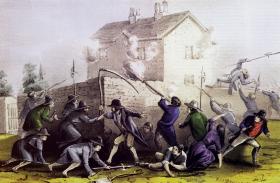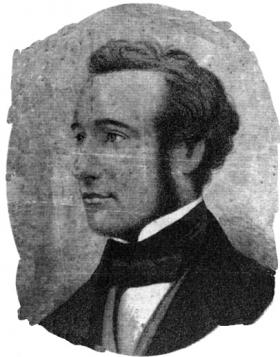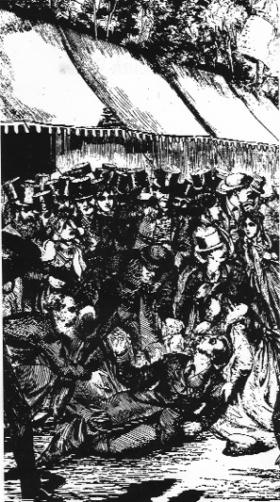The IRB: ‘a natural outcome of Young Irelandism’?
Published in 18th–19th - Century History, Features, General, Issue 6 (Nov/Dec 2008), Volume 16
The attack on the Widow McCormack’s house at Ballingarry, Co. Tipperary, 29 July 1848. Unwilling to sanction even the commandeering of private property, William Smith O’Brien’s rising ended in the inglorious failure to dislodge less than 50 police within. (Currier and Ives)
James Stephens and John O’Mahony, the formal founders of the Irish Republican Brotherhood in 1858, had been out in ’48 but questioned the leadership of William Smith O’Brien. Unwilling to sanction even the commandeering of private property, O’Brien’s rising ended in the inglorious failure to dislodge less than 50 police from Widow McCormack’s house near Ballingarry.
Stephens obtained no support from O’Brien
When James Stephens toured Ireland to create a new revolutionary movement he obtained no support from O’Brien, to whom secrecy and oath-taking to an Irish Republic, ‘now virtually established’, were anathema. Stephens, then in cooperation with O’Mahony, in 1858 initiated his new movement. An important unit was Jeremiah O’Donovan Rossa’s Phoenix Society of Skibbereen, which incautiously cited Smith O’Brien. Alexander Sullivan, editor of the Nation, publicly attacked this grouping. O’Brien agreed and repudiated secret organisations. Fenians denounced Sullivan as a felon-setter, although the authorities were already aware of the Phoenix men.
In America Stephens tried to persuade Mitchel and Meagher to raise money for the Fenians. Mitchel was sceptical of Stephens’s claim to have recruited 15,000 sworn and armed Confederates (as Fenians were then called) in Ireland, and refused to assist. It appears that Mitchel did make a contribution to the cause, however, while Meagher was originally most enthusiastic. But the American Civil War (1861–5) split Mitchel and Meagher: while the former produced propaganda for the South, the latter led an Irish Brigade for the North. Smith O’Brien, who visited the United States in 1859, urged the Irish to avoid committing to either side; others thought the military experience useful in the event of an Irish revolution. Terence Bellew MacManus proved most useful to the Fenians on his death in 1861. They returned his body to Ireland and, despite the hostility of Archbishop Cullen, organised a massive funeral demonstration that established Fenianism as a popular cause. Smith O’Brien, outmanoeuvred by Stephens, sent his carriage to the funeral as a gesture of respect, though he probably did not attend himself.

Terence Bellew MacManus, the Young Irelander most useful to the Fenians on his death in 1861. They returned his body to Ireland and, despite the hostility of Archbishop Cullen, organised a massive funeral demonstration that established Fenianism as a popular cause. (National Museum of Ireland)
Duffy and McGee denounced by the Irish People
From 1863 until its suppression in September 1865, Stephens, aided by former Young Irelanders John O’Leary, Charles Kickham and T. C. Luby, openly published the Irish People to prepare for revolution. The paper dealt roughly with several Young Ireland leaders. When John Martin, with the tacit support of O’Brien, became leader of a constitutionalist Irish League, the Irish People was hostile. Martin dared to defend D’Arcy McGee, a Young Irelander who, escaping to America, had become a monarchist politician in Canada. McGee opposed Irish-American designs on Canada, arguing that the Irish were happier in the British territory. According to the Irish People, ‘of all the Young Ireland leaders, he has receded farthest in the rebound or reaction which followed upon the collapse of that unhappy “year of revolutions” [1848]’. Gavan Duffy, to whom McGee had been a toady, had, according to the Irish People, dropped part of his old creed also. Duffy, as the recipient of a pension from the queen, was now shouted down in Ireland. Even Martin and Dillon, declared the Fenian paper, would probably not accept McGee now. (McGee was later assassinated by a Fenian in 1868.)
Fenians wrecked a meeting in Dublin when moderates such as Alexander Sullivan and John Martin suggested a monument to Queen Victoria’s recently dead husband, Prince Albert. O’Brien, in the Nation, publicly denounced this vandalism by an organisation which had ‘obstructed all other national movements, and which has brought disgrace upon those who would otherwise have been proud to call themselves “Nationalists”’. The Irish People retaliated by questioning O’Brien’s qualifications for such assertions, claiming that his books and pamphlets had never risen above mediocrity, yet conceding that he had risked his life for Ireland with ‘a certain nobility of character’ which partly compensated for his ‘questionable conduct of late years’. When O’Brien died in 1864 there was no editorial eulogy from the Irish People. In his travels through Europe, O’Brien had been impressed by the non-violent constitutionalism of the Hungarian leader Ferenz Déak, who in 1867 helped to bring about the Ausgleich (dual monarchy) settlement with Austria, an idea later taken up by Arthur Griffith and Sinn Féin.
Cardinal Cullen’s National Association

The attempted assassination of Prince Alfred, Queen Victoria’s son, in Sydney in March 1868 by the unbalanced Henry O’Farrell, who claimed to be a Fenian, led to unfounded accusations that Charles Gavan Duffy, later to become premier of Victoria, was a closet Fenian.
There was thus a clear division in Ireland between the remnants of the senior 1848 men and the younger men who had set up the Irish People. John Dillon, a founder of the Nation, now went a step further in opposition to Fenianism. He joined the National Association promoted by Cardinal Cullen to fight for Catholic education while presenting a particularly mild form of Irish nationalism in opposition to Fenian revolt. The Protestant John Martin welcomed the National Association alongside the League as an ally: ‘It is a valuable thing for Ireland to have the Catholic bishops, even Dr Cullen, committed to patriotic exertions. Good will surely come of it.’ The Irish People was vituperative. Martin hoped that ‘the Fenian delusion’ would soon come to an end. The American Civil War concluded in 1865, however, leaving considerable numbers of Irishmen with military experience. Nevertheless, an Irish rebellion failed to take off in that year. Instead, the authorities raided the Irish People in late 1865 and arrested its staff. Stephens managed to escape.
In America, the failure to rise in 1865 caused division in Fenian ranks. Stephens and O’Mahony now lost their influence. They were replaced by W. R. Roberts of the so-called ‘Senate Wing’ of the movement, which promoted a Fenian invasion of Canada, connived at by the US administration, as a necessary prelude to any further advance in Ireland. An invasion of Canada in 1866 failed after some initial success and plans were made for an Irish rising in the following year.
Mitchel joins . . . and then quits the movement
John Mitchel, imprisoned by the victorious North after the Civil War, on his release formally joined the Fenians. Despite his previous irritation with Stephens, Mitchel moved to Paris in November 1865 as administrator of Fenian finances. He was soon disillusioned. Again he discovered that Stephens vastly overrated Fenian resources. In June 1866 Mitchel quit the movement. He asserted that no rising could succeed unless England was at war with a great power. Stephens bungled the insurgent preparations so badly that he was deposed as leader before it began. Another Irish revolutionary failure occurred on a miserable evening in March 1867. At the same time Martin’s Irish League petered out through lack of interest.
While disagreeing with Martin’s quasi-constitutionalist approach, Mitchel was scathing about the latest attempt at rebellion:
‘And of one thing you may be well assured—that the Irish national spirit on this continent, as well as in Ireland, suffers nothing by the collapse of that enormous sack of gas called Fenianism . . . The Fenian enterprises were wildly impracticable—unscrupulous delusions were employed to induce men of military knowledge to enter into those enterprises—dreadful suffering has been brought upon over a thousand Irish families in consequence of Fenianism.’
Hearing that another Fenian attack on Canada was considered, Mitchel, who had twice been offered the Fenian presidency, ridiculed the idea. When it occurred in 1870 it was as big a disaster as the rest. Mitchel claimed to have declared war on Fenianism. While Fenian prisoners faced the Irish courts in July 1867, his former comrade, Thomas Meagher, appointed acting governor of Montana, mysteriously drowned. A Fenian convention only narrowly passed a vote of condolence on his death.
Although the 1867 Rising had failed, in November 1867 the hanging of the three Manchester Martyrs reunited Irish opinion. Ireland resounded with mock funerals bearing empty coffins. John Martin and Alexander Sullivan were arrested and tried for their part in the Dublin funeral (Martin was acquitted, while Sullivan was jailed for 100 days). In the United States Mitchel also expressed his approbation for the executed martyrs. In Australia, Gavan Duffy had assiduously avoided mentioning Fenianism in speech and writing. In Sydney, in March 1868, the unbalanced Henry O’Farrell, claiming to be a Fenian, had tried to shoot Queen Victoria’s son, Prince Alfred; Duffy was unreasonably accused of being a closet Fenian supporter.
After the failure of the second attack on Canada, the importance of Fenianism lay in its maintenance of a tradition of physical force, leading ultimately to the 1916 Rising. John Mitchel (briefly a member) was the only Fenian Patrick Pearse placed amongst his four ‘fathers of Irish nationalism’, however, and he was a tough critic of the tactics, if not the objects, of the brotherhood. Yet the famous revolutionary dates—’98, ’48, ’67 and ’16—still run together. Alexander Sullivan traced the tension between Fenianism and some older leaders of Young Ireland to the clash between John Mitchel and Gavan Duffy over nationalist tactics in early 1848, when Mitchel wanted a more rapid appeal to force. It could be traced back even further to the original clash between O’Connell and the Young Irelanders over non-violence. Irish history, up to the present, has seen a persistent interplay between force and constitutionalism.
Richard Davis is emeritus professor of history at the University of Tasmania and a Fellow of the Australian Academy of the Humanities.
Further reading:
R.V. Comerford, The Fenians in context: Irish politics and society 1848–82 (Dublin, 1985).
R.P. Davis, The Young Ireland Movement (Dublin, 1987).
R.P. Davis, Revolutionary imperialist: William Smith O’Brien, 1803–1864 (Dublin, 1998).
J. Devoy, Recollections of an Irish rebel (Dublin, 1929, 1969).
















